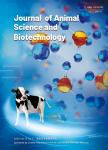Dietary sodium acetate and sodium butyrate improve high-carbohydrate diet utilization by regulating gut microbiota, liver lipid metabolism, oxidative stress, and inflammation in largemouth bass(Micropterus salmoides)
作者机构:College of Animal Science and TechnologySichuan Agricultural UniversityChengdu 611130SichuanChina
出 版 物:《Journal of Animal Science and Biotechnology》 (畜牧与生物技术杂志(英文版))
年 卷 期:2024年第15卷第4期
页 面:1704-1722页
核心收录:
学科分类:1002[医学-临床医学] 0905[农学-畜牧学] 100201[医学-内科学(含:心血管病、血液病、呼吸系病、消化系病、内分泌与代谢病、肾病、风湿病、传染病)] 10[医学]
基 金:supported by the Double Support Project (035–2221993229)
主 题:High carbohydrate diet Intestinal microbiota Largemouth bass Lipid deposition Sodium acetate Sodium butyrate
摘 要:Background Adequate level of carbohydrates in aquafeeds help to conserve protein and reduce cost. However, studies have indicated that high-carbohydrate(HC) diet disrupt the homeostasis of the gut–liver axis in largemouth bass, resulting in decreased intestinal acetate and butyrate *** Herein, we had concepted a set of feeding experiment to assess the effects of dietary sodium acetate(SA) and sodium butyrate(SB) on liver health and the intestinal microbiota in largemouth bass fed an HC diet. The experimental design comprised 5 isonitrogenous and isolipidic diets, including LC(9% starch), HC(18% starch), HCSA(18% starch;2 g/kg SA), HCSB(18% starch;2 g/kg SB), and HCSASB(18% starch;1 g/kg SA + 1 g/kg SB). Juvenile largemouth bass with an initial body weight of 7.00 ± 0.20 g were fed on these diets for 56 *** We found that dietary SA and SB reduced hepatic triglyceride accumulation by activating autophagy(ATG101, LC3B and TFEB), promoting lipolysis(CPT1α, HSL and AMPKα), and inhibiting adipogenesis(FAS, ACCA, SCD1 and PPARγ). In addition, SA and SB decreased oxidative stress in the liver(CAT, GPX1α and SOD1) by activating the Keap1-Nrf2 pathway. Meanwhile, SA and SB alleviated HC-induced inflammation by downregulating the expression of pro-inflammatory factors(IL-1β, COX2 and Hepcidin1) through the NF-κB pathway. Importantly, SA and SB increased the abundance of bacteria that produced acetic acid and butyrate(Clostridium_sensu_stricto_1). Combined with the KEGG analysis, the results showed that SA and SB enriched carbohydrate metabolism and amino acid metabolism pathways, thereby improving the utilization of carbohydrates. Pearson correlation analysis indicated that growth performance was closely related to hepatic lipid deposition, autophagy, antioxidant capacity, inflammation, and intestinal microbial *** In conclusion, dietary SA and SB can reduce hepatic lipid deposition;and alleviate oxidative stress and inflammation in largemout



